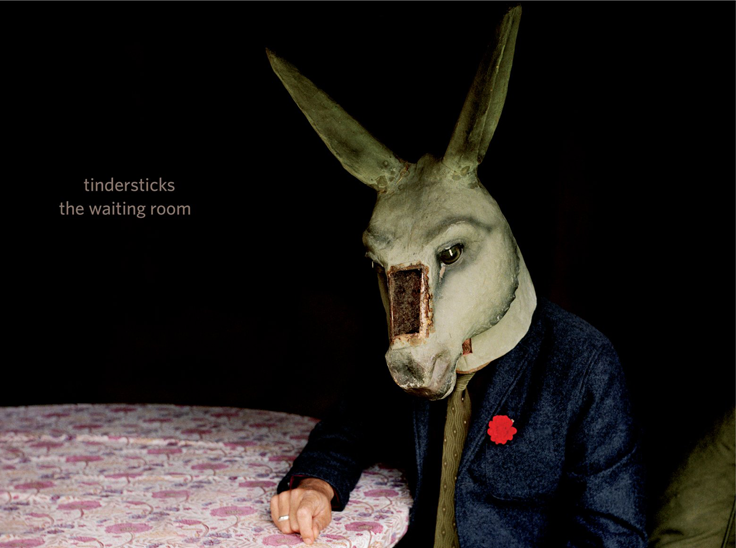
The veteran Alternative band Tindersticks released their latest effort The Waiting Room on January 22, 2016. The Waiting Room is their 11th album and follows their retrospective release Across Six Leap Years and their 2012 original content release The Something Rain. Known as a “thinking person’s” band they have always focused on restless intellectualism in their music. This time they have doubled down on their emphasis on poetic human emotion. “The Waiting Room” is an ambitious and introspective release.
The Tindersticks were founded in 1991, forming in Nottingham, England. The group has seen a number of personnel changes throughout the years; the most significant in 2005 when lead singer Stuart Staples embarked on a solo career and the band temporarily split up. They reformed again a short while later. The band’s latest roster consists of Stuart Staples on vocals and guitar, David Boulter on organ and accordion, Neil Fraser on guitar, Dan McKenna on bass and Earl Harvin on drums. The Waiting Room was recorded in Limousin, France in a studio that Staples and the band built. The Tindersticks through the years has been characterized as alternative lounge jazz with an orchestral background as they are renowned for utilizing a plethora of instruments. Possibly because of years of soundtrack involvement, their music has always had a cinematic bend. This proclivity is manifesting itself with the Tinderstick’s collaboration with the Clermont-Ferand International Short Film Festival to have independent directors produce a short film for each song on the current release.
On The Waiting Room an immediate noticeable difference from prior releases is Staples setting his guitar down and concentrating on his vocals, which were always a stand-out, but this time seem to have a special spotlight shown upon them. The bass, organ, drums and lavish brass also seem to rule the day bringing about a larger focus to the music. Throughout the release the band shapeshifts through numerous genres; jazz, krautrock, Afro beat, and found sounds. There are also some fantastic guest appearances, the most touching being the late Lhasa De Sela’s duet with Staples on Hey Lucinda. Jehnny Beth of Savages appears on We are Dreamers making it an even more spectacular track and Julian Siegel provides the arresting brass arrangements throughout the release.
There are tight tensions at work on “The Waiting Room” as simplicity is counterbalanced by a sense of urgency. What pervades the release is an underlying sense at attempting to gather one’s self together after having lost and been devastated by the deaths of friends and family. “The Waiting Room” has a menacing grandeur. The album starter Follow Me is a brief instrumental with a forlorn aura; it is a cover of a song used in the 1960 version of Mutiny on the Bounty, Brando version. The song segues into Second Chance Man, here Staples voice is the main feature. The song discusses the many chances there are to repair things in relationships, and advises taking advantage of those opportunities before there is no chance to make things right. It is a sublime and moving selection deftly performed. Were We Lovers? is another captivating track. The song has a glistening sound and the bass line defines the track. The minimal orchestration wrings emotion out of the empty spaces underlining the poignancy of the topic and lyrics. Staples examines how memory defines a person and the ideas of forgotten intimacy. He points out mankind’s ability to conveniently or inconveniently forget the past. The lyric asks “How can I care it it’s the caring that’s killing me?” pointing out the eventual realization is that it may be necessary to forget in order to continue living.
The fantastically funky song, Help Yourself has an amazing Afro beat track that sounds like it is married to the jazz stylings of early Sun Ra. The song itself came together very quickly for the band and again the emphasis is on Staples voice as it enhances the track.
Certainly to be treasured is Hey Lucinda a duet with a beautiful dreamy intro. The duet is made more special by the appearance of vocalist Lhasa De Sela, Staples close friend, who lost her battle with cancer in 2009 shortly after recording the track. The song does not dwell on her untimely death or sadness, but instead is a quirky tune about relationships from a woman’s point of view. Here the woman is in the driver’s seat and the guy is clinging on for dear life to the relationship. She is spinning him along as she states “I might be waiting for you,” you can practically hear the indifferent shrug. It is a brilliant song made even more so by the vocals of both performers.
The second instrumental of the release is Fear of Emptiness which has this interstellar feeling as it captured the rain falling on paella pans, then proceeds to a more digital techy song and concludes with a shimmering cacophony. The instrumental interludes throughout the release are like a palate cleanser before proceeding to the next section of the album.
How He Entered is an engaging song where the time signature builds the tension of the song. Bassist Dan McKenna came up with the song and it has this interesting guitar/piano melody. The poetic song describes men as they enter a room, encountering many things; a new experience, being a fugitive, hope, anticipation, despair, fear, sadness, loneliness and chance. It is a low key but gripping experience. The title track, The Waiting Room utilizes the image of the medical waiting room and equating it to life being a waiting room for what comes after. It is elegiac and introspective as it asks for mercy from the pain of life in lyrics like, Don’t let me suffer. The organ is very evocative and moody. The final instrumental Planting Holes is an older song where again the found sound of rain falling on paella pans is utilized along with glistening keyboards. The song is an open contemplation that allows for a great segue way into the song, We are Dreamers.
We are Dreamers main feature is the interwoven vocals of Jehnny Beth from Savages and Staples. It contains a gorgeous horn arrangement intro then moves into a distorted guitar that engenders the emotions of this song. Beth’s voice provides the dream like feel to this ever expanding majestic track with a jumble of ideas and thoughts that convey the surreal atmosphere of our subconscious usually most evident in dreams. It is a not to be missed track.
The final track, Like Only Lovers Can has a delightful keyboard that intertwines with acoustic guitars. The song’s main sonic inspiration comes from a sound check in Dresden that was recorded on Staples phone. It is brooding and in many ways intentionally does not bring the album to a neat ending, it leaves many questions unanswered; “you never know what you see when you stare too long.” It is a fantastic end to an inventive and evocative release.
The Waiting Room reintroduced me to the Tindersticks and I really enjoyed the listen. The music is well constructed and performed. The lyrics and themes are definitely deep and emotionally satisfying. It is perfect for those grey and introspective months of January and February. The ebb and flow of the album is perfect with the pace and topic never left to get too maudlin, regretful or bittersweet. There is a relaxation in the release and detachment instead of anxiety about the worries of the world. It is life as if seen through the other side of a window. It becomes a coin flip over whether it is sweetly sad or sadly sweet, but there is a definite evocative ache. The Waiting Room is certainly a testament to Tindersticks progression from journeymen music makers into artisan musical masters.


Be the first to comment